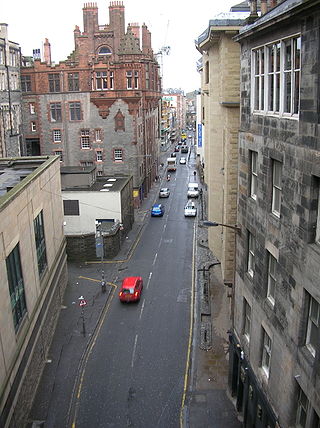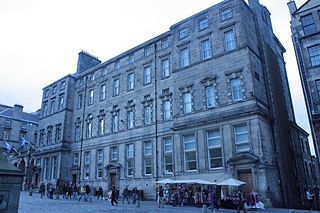
George IV Bridge is an elevated street in Edinburgh, Scotland, and is home to a number of the city's important public buildings.

George IV Bridge is an elevated street in Edinburgh, Scotland, and is home to a number of the city's important public buildings.
A bridge connecting the Royal Mile to the south was first suggested as early as 1817, but was first planned further west and was non-linear and complicated. [1] [2] Plans developed through the 1820s, concluding in 1825 that a linear form aligned with Bank Street (which then connects to The Mound and Princes Street was more logical, even though this required more destruction of existing buildings. This would bridge over the Cowgate and Merchant Street. The foundation stone was laid on 15 August 1827. [3] Measuring 300 metres (330 yd) in length, the bridge was constructed between 1827 and 1836 as part of the Edinburgh Improvement Act of 1827. [4]
Named after King George IV, it was designed by architect Thomas Hamilton (1784–1858) to connect the South Side district of Edinburgh to the Old Town (Royal Mile) and then use exiting streets on the north to connect to the New Town. Two of Edinburgh Old Town's traditional streets, Old Bank Close, Gosford Close, Mauchine's Close and Liberton Wynd, had to be demolished for the construction of the bridge. [5] This included the loss of the legendary John Dowie's Tavern on Liberton Wynd. [6]
On 24 August 2021, a fire thought to have started in Patisserie Valerie on the bridge destroyed several businesses both on and below one end of the bridge; others were damaged by flooding from the firefighting. [7] The alarm was raised at approximately 6:20 AM by a cleaner at the next door Elephant House café, who detected smoke. [8] Nine fire engines and two ladder vehicles attended the fire. Apartments above were evacuated, and Candlemaker Row and Chambers Street were both closed. [9]
The Oz Bar in Candlemaker Row was one of the businesses heavily damaged. [9] Workers stripping plaster detached from the walls by the flooding found a back entrance to Brown Square, a residential development for the wealthy from the early 1760s that was demolished to build the bridge. [7]

At the north end of the street, on the east side, where it joins the Royal Mile (Lawnmarket), stands Lothian Chambers which is now the offices of French Consulate-General. [10] Opposite it, on the west side, was a row of Category B listed tenements at 1–12 Melbourne Place, demolished in 1966–67 to make way for an additional office building for Midlothian County Council, designed in 1968 by Robert Matthew of Robert Matthew Johnson Marshall partners but cleared away to make way for a new hotel development originally for Missoni, but now the G & V Hotel. [11]

Further south on the street lie the National Library of Scotland and (opposite) the Edinburgh Central Library, the latter being one of the many free libraries constructed with money provided by the Scottish-born philanthropist Andrew Carnegie. Around the middle of the street, where the bridge crosses the historic Cowgate, are located a number of bars and restaurants and takeaways, as well as the ESL institute Wallace College and the Augustine United Church. The former Elim Pentecostal Church has been converted to a public house. [12]
At the southern end of the street is the junction with Candlemaker Row, where there is the statue of Greyfriars Bobby. Opposite is the junction with Chambers Street, where the National Museum of Scotland is located. [13]
The road continues south for a short section, not truly part of the bridge and formerly known as Lindsay Place, to a Y-junction where it diverges to become Bristo Place and Forrest Road, the Bedlam Theatre (formerly the New North Free Church) sits at the meeting point of these two roads. [14]

Midlothian is a historic county, registration county, lieutenancy area and one of 32 council areas of Scotland used for local government. Midlothian lies in the east-central Lowlands, bordering the City of Edinburgh, East Lothian and the Scottish Borders.

The Royal Mile is a succession of streets forming the main thoroughfare of the Old Town of the city of Edinburgh in Scotland. The term was first used descriptively in W. M. Gilbert's Edinburgh in the Nineteenth Century (1901), describing the city "with its Castle and Palace and the royal mile between", and was further popularised as the title of a guidebook by R. T. Skinner published in 1920, "The Royal Mile (Edinburgh) Castle to Holyrood(house)".

William Brodie, often known by his title of Deacon Brodie, was a Scottish cabinet-maker, deacon of a trades guild, and Edinburgh city councillor, who maintained a secret life as a housebreaker, partly for the thrill, and partly to fund his gambling.

Thomas Hamilton was a Scottish architect, based in Edinburgh where he designed many of that city's prominent buildings. Born in Glasgow, his works include: the Burns Monument in Alloway; the Royal High School on the south side of Calton Hill ; the Royal College of Physicians of Edinburgh; the George IV Bridge, which spans the Cowgate; the Dean Orphan Hospital, now the Dean Gallery; the New North Road Free Church, now the Bedlam Theatre; Cumstoun, a private house in Dumfries and Galloway; and the Scottish Political Martyrs' Monument in Old Calton Cemetery, Edinburgh.

The Cowgate is a street in Edinburgh, Scotland, located about 550 yards (500 m) southeast of Edinburgh Castle, within the city's World Heritage Site. The street is part of the lower level of Edinburgh's Old Town, which lies below the elevated streets of South Bridge and George IV Bridge. It meets the Grassmarket at its west end and Holyrood Road to the east.

This article is a timeline of the history of Edinburgh, Scotland, up to the present day. It traces its rise from an early hill fort and later royal residence to the bustling city and capital of Scotland that it is today.

Greyfriars Kirk is a parish church of the Church of Scotland, located in the Old Town of Edinburgh, Scotland. It is surrounded by Greyfriars Kirkyard.
Edinburgh, the capital of Scotland, is traditionally said to have been "built on Seven Hills", in an allusion to the seven hills of Rome. While there is considerable room for debate as to which hills are included and excluded from the seven, seven possibilities are listed in an old rhyme:

The Old Town is the name popularly given to the oldest part of Scotland's capital city of Edinburgh. The area has preserved much of its medieval street plan and many Reformation-era buildings. Together with the 18th/19th-century New Town, and West End, it forms part of a protected UNESCO World Heritage Site.

Great Junction Street is a street in Leith, on the northern outskirts of Edinburgh, Scotland. It runs southeast to northwest following approximately the southwestmost line of the old town walls around Leith.

South Bridge is a road bridge and street in Edinburgh, Scotland, between the High Street and Chambers Street/Infirmary Street. It extends to North Bridge at the north and Nicolson Street at the south, forming a level roadway over the steep valley scoured parallel to the High Street when the crag and tail landscape was formed. The Cowgate roadway along the bottom of the valley runs under the largest arch of the bridge.

There have been several town walls around Edinburgh, Scotland, since the 12th century. Some form of wall probably existed from the foundation of the royal burgh in around 1125, though the first building is recorded in the mid-15th century, when the King's Wall was constructed. In the 16th century the more extensive Flodden Wall was erected, following the Scots' defeat at the Battle of Flodden in 1513. This was extended by the Telfer Wall in the early 17th century. The walls had a number of gates, known as ports, the most important being the Netherbow Port, which stood halfway down the Royal Mile. This gave access from the Canongate which was, at that time, a separate burgh.

Ebenezer James MacRae was a Scottish architect serving as City Architect for Edinburgh for most of his active life.

The Greyfriars Bobby Fountain is a granite fountain in Edinburgh, surmounted by a bronze life-size statue of Greyfriars Bobby, a Skye Terrier who became known in 19th-century Edinburgh for supposedly spending 14 years guarding the grave of his owner John Gray until the dog itself died on 14 January 1872.
Walter Brown (c.1770–c.1840) was a Scottish wine merchant who served as Lord Provost of Edinburgh from 1827 to 1829.

John Dowie's Tavern was an 18th/19th century tavern in Edinburgh, Scotland, frequented by a number of well-known persons. Its proximity to the Edinburgh law courts also meant it was a haunt of Edinburgh lawyers and judges.

Lothian Chambers, formerly Midlothian County Buildings, is a municipal structure on George IV Bridge in Edinburgh, Scotland. The structure, which accommodates the Consulate-General of France and the French Institute for Scotland, is a Category B listed building.